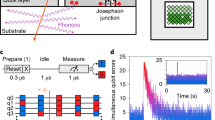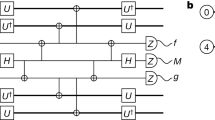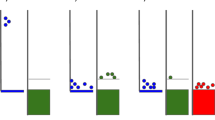Abstract
The central challenge in building a quantum computer is error correction. Unlike classical bits, which are susceptible to only one type of error, quantum bits (qubits) are susceptible to two types of error, corresponding to flips of the qubit state about the X and Z directions. Although the Heisenberg uncertainty principle precludes simultaneous monitoring of X- and Z-flips on a single qubit, it is possible to encode quantum information in large arrays of entangled qubits that enable accurate monitoring of all errors in the system, provided that the error rate is low1. Another crucial requirement is that errors cannot be correlated. Here we characterize a superconducting multiqubit circuit and find that charge noise in the chip is highly correlated on a length scale over 600 micrometres; moreover, discrete charge jumps are accompanied by a strong transient reduction of qubit energy relaxation time across the millimetre-scale chip. The resulting correlated errors are explained in terms of the charging event and phonon-mediated quasiparticle generation associated with absorption of γ-rays and cosmic-ray muons in the qubit substrate. Robust quantum error correction will require the development of mitigation strategies to protect multiqubit arrays from correlated errors due to particle impacts.
This is a preview of subscription content, access via your institution
Access options
Access Nature and 54 other Nature Portfolio journals
Get Nature+, our best-value online-access subscription
$29.99 / 30 days
cancel any time
Subscribe to this journal
Receive 51 print issues and online access
$199.00 per year
only $3.90 per issue
Buy this article
- Purchase on Springer Link
- Instant access to full article PDF
Prices may be subject to local taxes which are calculated during checkout




Similar content being viewed by others
Data availability
The data shown in this paper are available upon request.
References
Fowler, A. G., Mariantoni, M., Martinis, J. M. & Cleland, A. N. Surface codes: towards practical large-scale quantum computation. Phys. Rev. A 86, 032324 (2012).
Barends, R. et al. Superconducting quantum circuits at the surface code threshold for fault tolerance. Nature 508, 500–503 (2014).
Sheldon, S. et al. Characterizing errors on qubit operations via iterative randomized benchmarking. Phys. Rev. A 93, 012301 (2016).
Jeffrey, E. et al. Fast accurate state measurement with superconducting qubits. Phys. Rev. Lett. 112, 190504 (2014).
Walter, T. et al. Rapid high-fidelity single-shot dispersive readout of superconducting qubits. Phys. Rev. Appl. 7, 054020 (2017).
Opremcak, A. et al. High-fidelity measurement of a superconducting qubit using an on-chip microwave photon counter. Phys. Rev. X 11, 011027 (2021).
Christensen, B. G. et al. Anomalous charge noise in superconducting qubits. Phys. Rev. B 100, 140503 (2019).
Vepsäläinen, A. P. et al. Impact of ionizing radiation on superconducting qubit coherence. Nature 584, 551–556 (2020).
Agostinelli, S. et al. GEANT4—a simulation toolkit. Nucl. Instrum. Methods Phys. Res. A 506, 250–303 (2003).
Allison, J. et al. GEANT4 developments and applications. IEEE Trans. Nucl. Sci. 53, 270–278 (2006).
Allison, J. et al. Recent developments in GEANT4. Nucl. Instrum. Methods Phys. Res. A 835, 186–225 (2016).
Shukla, P. & Sankrith, S. Energy and angular distributions of atmospheric muons at the Earth. Preprint at https://arxiv.org/abs/1606.06907 (2018).
Ramanathan, K. & Kurinsky, N. Ionization yield in silicon for eV-scale electron-recoil processes. Phys. Rev. D 102, 063026 (2020).
Brandt, D. et al. Semiconductor phonon and charge transport Monte Carlo simulation using GEANT4. Preprint at https://arxiv.org/abs/1403.4984 (2014).
Kelsey, M., Agnese, R., Brandt, D. & Redl, P. G4CMP: GEANT4 add-on framework for phonon and charge-carrier physics. https://github.com/kelseymh/G4CMP (2020).
Moffatt, R. A. et al. Spatial imaging of charge transport in silicon at low temperature. Appl. Phys. Lett. 114, 032104 (2019).
Martinis, J. M., Ansmann, M. & Aumentado, J. Energy decay in superconducting Josephson-junction qubits from nonequilibrium quasiparticle excitations. Phys. Rev. Lett. 103, 097002 (2009).
Lenander, M. et al. Measurement of energy decay in superconducting qubits from nonequilibrium quasiparticles. Phys. Rev. B 84, 024501 (2011).
Wenner, J. et al. Excitation of superconducting qubits from hot nonequilibrium quasiparticles. Phys. Rev. Lett. 110, 150502 (2013).
Wang, C. et al. Measurement and control of quasiparticle dynamics in a superconducting qubit. Nat. Commun. 5, 5836 (2014).
Serniak, K. et al. Hot nonequilibrium quasiparticles in transmon qubits. Phys. Rev. Lett. 121, 157701 (2018).
Ristè, D. et al. Millisecond charge-parity uctuations and induced decoherence in a superconducting transmon qubit. Nat. Commun. 4, 1913 (2013).
Catelani, G., Schoelkopf, R. J., Devoret, M. H. & Glazman, L. I. Relaxation and frequency shifts induced by quasiparticles in superconducting qubits. Phys. Rev. B 84, 064517 (2011).
Dell’Oro, S., Marcocci, S., Viel, M. & Vissani, F. Neutrinoless double beta decay: 2015 review. Adv. High Energy Phys. 2016, 1–37 (2016).
Poda, D. & Giuliani, A. Low background techniques in bolometers for double-beta decay search. Int. J. Mod. Phys. A 32, 1743012 (2017).
Baudis, L. The search for dark matter. Eur. Rev. 26, 70–81 (2018).
Pirro, S. & Mauskopf, P. Advances in bolometer technology for fundamental physics. Annu. Rev. Nucl. Part. Sci. 67, 161–181 (2017).
Szücs, T. et al. Background in γ-ray detectors and carbon beam tests in the Felsenkeller shallow-underground accelerator laboratory. Eur. Phys. J. A 55, 174 (2019).
Aglietta, M. et al. Muon ‘depth–intensity’ relation measured by the lvd underground experiment and cosmic-ray muon spectrum at sea level. Phys. Rev. D 58, 092005 (1998).
Jillings, C. The SNOLAB science program. J. Phys. Conf. Ser. 718, 062028 (2016).
Alessandria, F. et al. Validation of techniques to mitigate copper surface contamination in CUORE. Astropart. Phys. 45, 13–22 (2013).
Aprile, E. et al. Material screening and selection for XENON100. Astropart. Phys. 35, 43–49 (2011).
Busto, J., Gonin, Y., Hubert, F., Hubert, P. & Vuilleumier, J.-M. Radioactivity measurements of a large number of adhesives. Nucl. Instrum. Methods Phys. Res. A 492, 35–42 (2002).
ILIAS Database. http://radiopurity.in2p3.fr (accessed November 2020).
Cardani, L. et al. Reducing the impact of radioactivity on quantum circuits in a deep-underground facility. Preprint at https://arxiv.org/abs/2005.02286 (2020).
Aumentado, J., Keller, M. W., Martinis, J. M. & Devoret, M. H. Nonequilibrium quasiparticles and 2e periodicity in single-Cooper-pair transistors. Phys. Rev. Lett. 92, 066802 (2004).
Patel, U., Pechenezhskiy, I. V., Plourde, B. L. T., Vavilov, M. G. & McDermott, R. Phonon-mediated quasiparticle poisoning of superconducting microwave resonators. Phys. Rev. B 96, 220501(R) (2017).
Martinis, J. M. Saving superconducting quantum processors from qubit decay and correlated errors generated by gamma and cosmic rays. Preprint at https://arxiv.org/abs/2012.06137 (2020).
Beckman, S. M. et al. Development of cosmic ray mitigation techniques for the LiteBIRD space mission. Proc. SPIE 10708, https://doi.org/10.1117/12.2314288 (2018).
Acknowledgements
We acknowledge stimulating discussions with R. Barends, I. M. Pop and J. M. Martinis. We thank S. Pirro for discussions and for sharing the results of his measurements of environmental radioactivity, J. W. Engle for assistance with the calibration of the NaI scintillation detector used to characterize background radioactivity in the laboratory in Madison, and A. Riswadkar for support with device fabrication. Work at UW-Madison was supported by the US Department of Energy (DOE), Office of Science, Basic Energy Sciences under award no. DE-SC0020313. Parts of this document were prepared using the resources of the Fermi National Accelerator Laboratory (Fermilab), a US DOE, Office of Science, HEP User Facility. Fermilab is managed by Fermi Research Alliance, LLC (FRA), acting under contract no. DE-AC02-07CH11359. Contributions from J.L.D. were performed under the auspices of the US DOE by Lawrence Livermore National Laboratory under contract DE-AC52-07NA27344. Parts of this work were supported by the DEMETRA start-up grant from INFN. The authors acknowledge use of facilities and instrumentation at the UW-Madison Wisconsin Centers for Nanoscale Technology, partially supported by the US National Science Foundation through the University of Wisconsin Materials Research Science and Engineering Center (DMR-1720415). We acknowledge the US Intelligence Advanced Research Projects Activity (IARPA) and Lincoln Laboratory for providing the travelling-wave parametric amplifier used in some of these experiments.
Author information
Authors and Affiliations
Contributions
C.D.W. and S.A. took and analysed the data. N.A.K. and C.S. simulated charge transport in the silicon substrate. L.C., G.D. and C.T. performed the GEANT4 simulations. L.F., L.B.I. and J.L.D. provided theoretical insights and support. C.H.L., A.O. and B.G.C. helped to develop the measurement and fabrication infrastructure. R.M. designed the experiment and directed data-taking and analysis. C.D.W., R.M., N.A.K. and L.C. co-wrote the manuscript.
Corresponding authors
Ethics declarations
Competing interests
The authors declare no competing interests.
Additional information
Peer review information Nature thanks Joseph Formaggio, Kevin Osborn and the other, anonymous, reviewer(s) for their contribution to the peer review of this work. Peer reviewer reports are available.
Publisher’s note Springer Nature remains neutral with regard to jurisdictional claims in published maps and institutional affiliations.
Supplementary information
Supplementary Information
This file includes supplementary text, figures s1–s10, supplementary tables, supplementary equations 1–20 and supplementary references.
Rights and permissions
About this article
Cite this article
Wilen, C.D., Abdullah, S., Kurinsky, N.A. et al. Correlated charge noise and relaxation errors in superconducting qubits. Nature 594, 369–373 (2021). https://doi.org/10.1038/s41586-021-03557-5
Received:
Accepted:
Published:
Issue Date:
DOI: https://doi.org/10.1038/s41586-021-03557-5
This article is cited by
-
Electron charge qubit with 0.1 millisecond coherence time
Nature Physics (2024)
-
Two-level system hyperpolarization using a quantum Szilard engine
Nature Physics (2023)
-
Phononic bath engineering of a superconducting qubit
Nature Communications (2023)
-
Realizing all-to-all couplings among detachable quantum modules using a microwave quantum state router
npj Quantum Information (2023)
-
Noise-correlation spectrum for a pair of spin qubits in silicon
Nature Physics (2023)
Comments
By submitting a comment you agree to abide by our Terms and Community Guidelines. If you find something abusive or that does not comply with our terms or guidelines please flag it as inappropriate.



